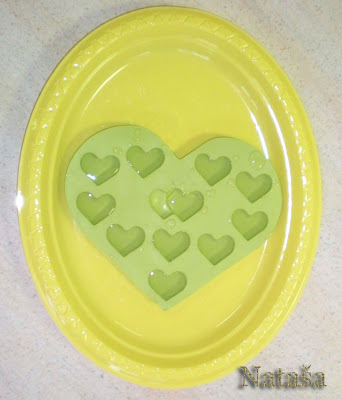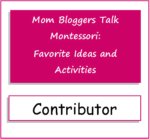Djeca su u petak, za vrijeme kruga, upoznala kruto, tekuće i plinovito stanje vode.
Prije doručka smo nalili vodu u kalup za led. Odnijeli smo ga u vrtićku kuhinju, u zamrzivač. Nakon individualnog rada s Montessori priborom, a prije nego što smo započeli vrijeme kruga, otišli smo u kuhinju po naš kalup za led.
~
Before breakfast, we poured water into the ice mold. We took it in the kindergarten kitchen, in the freezer. After the individual work with the Montessori materials, and before we started our circle time, we went to the kitchen for our ice mold.
Nakon dolaska u sobu razgovarali smo o tome što se desilo s vodom u kalupu, zašto to više nije voda nego led, sva djeca su opipavala led (komentirali su da je jaaaaako hladan, a neki su nakon opipavanja polizali prstiće i zaključili da led nema okus kao niti voda :-) ). Na kraju razgovora i proučavanja zaključili smo da se voda pretvorila u led; voda može biti u krutom stanju.
~
When we returned to our classroom we talked about what happened to the water in the mold, why it is no longer water, but ice, all the children felt the ice (commented that it is veeeeery cold, and some of them licked their fingers after palpation and concluded that ice does not taste, nor water :-)). At the end of the discussion and study, we concluded that the water turned into ice, the water can be in solid form.
Posudu s ledom sam stavila na radijator. Rekla sam djeci da poslije vremena kruga idemo u šetnju, a kad se vratimo pogledat ćemo što se desilo s našim ledom.
Zatim sam djeci pokazala posudu s običnom vodom. Djeca su lako zaključila da je to voda u tekućem stanju.
~
I put on a radiator bowl with ice. I told the children that after the circle time we go for a walk, and when we return we will look at what happened with our ice.
Then I showed the children a dish of plain water. Children are easily conclude that it was liquid water.
~
I put on a radiator bowl with ice. I told the children that after the circle time we go for a walk, and when we return we will look at what happened with our ice.
Then I showed the children a dish of plain water. Children are easily conclude that it was liquid water.

Pitala sam djecu može li se voda pretvoriti u plinovito stanje. Svi su jednoglasno zaključili da ne može. Pitali su se kako bi nešto što može biti tvrdo kao led ili nešto tako opipljivo kao svakodnevna voda moglo postati plin. Nakon toga sam u kuhalo za vodu nalila malo vode. Uključila sam kuhalo za vodu u struju. Nisam djeci rekla što će se dogoditi; rekla sam da čekaju i vidjet će sami. Kad je voda proključala, iz kuhala za vodu je počela izlaziti para (na žalost, ne vidi se na slici ispod).
~
I asked the children for their opinion - whether the water can convert into gaseous state. All the children unanimously concluded that it can not. They were wondering how it can be that something that can be hard as ice or something so tangible as a daily water could become a gas. After that I poured a little water in our electric kettle. I have not told the children what will happen, I told them to wait and see themselves. When the water boil from the kettle started getting water in its gaseous state - steam (unfortunately not visible in the picture below).
Zaključili smo da voda zagrijavanjem prelazi u plinovito stanje koje zovemo para. Na visokoj temperaturi prelazi iz tekućine u plinovito stanje. Kad sam podigla poklopac od kuhala za vodu, na njemu su se pojavile kapljice vode. Objasnila sam djeci da je to zbog nagle promjene temperature - u kuhalu je kipuće, a na sobnoj temperaturi je puno hladnije. Podsjetila sam djecu da pogledaju istu pojavu kod kuće u kuhinji - kad se kuha ručak, prozori se također "znoje".
~
We concluded that the water under temperature increase exceeds the gas that we call steam. At high temperature, it is changing from a liquid to gaseous state. When I lifted the lid of the kettle, the water droplets appeared on it. I explained to the children that this is due to sudden temperature changes - the stove is boiling, and at room temperature is much cooler. I reminded the children to look the same phenomenon at home in the kitchen - when lunch is cooking, the windows may also "sweat".
~
We concluded that the water under temperature increase exceeds the gas that we call steam. At high temperature, it is changing from a liquid to gaseous state. When I lifted the lid of the kettle, the water droplets appeared on it. I explained to the children that this is due to sudden temperature changes - the stove is boiling, and at room temperature is much cooler. I reminded the children to look the same phenomenon at home in the kitchen - when lunch is cooking, the windows may also "sweat".
Moram priznati da su djeca bila jako zainteresirana za ovaj eksperiment. Iznad mojih očekivanja. I za vrijeme šetnje oko našeg vrtića, raspravljala su o onom što se događalo :-) Zaključili smo da vodu svakodnevno susrećemo najčešće u tekućem stanju.
Kad smo se vratili u našu sobu provjerili smo što se desilo s ledom koji je ostao na toplom. Počeo se topiti:
~
I must admit that the children were very interested in this experiment. Beyond my expectations. And while walking around our kindergarten, they discussed what happened :-) We concluded that we encounter water every day most often in liquid form.
When we returned to our room we checked what happened with the ice left on our radiator. He began to thaw:
















































Hi! I have an award for you. THANK YOU.
OdgovoriIzbrišiEvelyn from 2 Pequenos Traviesos
http://2pequenostraviesos.blogspot.com/
PS: I love the experiment you did with your kids. Pictures are beautiful!
What a GREAT experiment! I love the ice mold, btw. :)
OdgovoriIzbrišiWOW! Thank you Evelyn :-) I'm so happy!
OdgovoriIzbrišiI'll post about it later today. It's midnight here in Croatia now.
Good night ;-)
Thanks Mari-Ann :-)
OdgovoriIzbrišiI have a lot of ice molds for practical life area. See my practical life label (left sidebar)if you want to.
What a nice, concrete way of presenting science facts. I'm sure that's a lesson that will make a lasting impression on the children. Thank you for this. :)
OdgovoriIzbrišiThanks Mars :-)
OdgovoriIzbrišiI'm glad you like it.
Very nice! I just popped over from your post on PreKinders forum! :)
OdgovoriIzbrišiAyn, thanks! So glad you like it :-)
OdgovoriIzbrišiWe did something very close to this experiment this week. Since we are at home, we ended up dropping some of the icecubes into a pot on the stove and the remaining ones in a cup on the counter. We compared which melted faster and why. .... but I think this is an upcoming post on my blog.
OdgovoriIzbrišiYour activity is also very educational for children. I can't wait to read post about it.
OdgovoriIzbriši